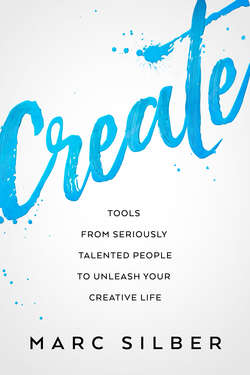Читать книгу Create - Marc Silber - Страница 26
На сайте Литреса книга снята с продажи.
ОглавлениеFind a work of art that you are particularly drawn to, as I was to the above painting by the artist’s use of curvy lines to express the mood of beauty and femininity.2 Observe closely to find what resonates for you. Take notes of your observations. What can you learn from this art? How did the artist use their canvas or other materials to present their story? What is your attention drawn to? Adjust these questions for the type of art you’re observing, listening to, reading, etc. The basic question is: what did the artist communicate to you?
Strengthening Your Visualization in Other
Areas of Life
The same approach that I have outlined of looking at art can be translated to any area of life you would like to add art or style to. For example, if you want to bring more creativity to your work, look for examples that you admire where this has been done. There are magazines such as FastCompany that delve into successful ways leaders and entrepreneurs have approached their mission creatively.
The same can be done with sports by studying those who have brought new approaches to their field. Every new advance in a sport was because someone had a new idea and was courageous enough to try it. As in the example of rock climbing, when I first learned, I pounded in Pitons (metal spikes and objects of various sizes to enable the climber to secure their rope to the rock). These had been used for decades in various iterations. But they had a huge drawback: they defaced the rocks: as more and more climbers covered a route, the rock was literally being beaten away.
In the 1960s some British climbers began to use ordinary machine nuts attached to a nylon runner in the place of pitons. Instead of being pounded in and out with hammers, they were placed in cracks by hand with no scaring of the rock. Then in 1972 Yvonne Chouinard began manufacturing them in various sizes (called nuts or chocks) and “clean climbing” became the norm for all climbers. Chouinard went on to found Patagonia, the very creative and extremely successful outdoor clothing and equipment company.
From here we could study the innovations of Patagonia both in their design of clothing and the way they conduct their business. Just to highlight a few of each: Their products come with a lifetime guarantee, but they take this a step further, by allowing trade-in of your clothing and gear, rather than tossing it out. This innovation was born out of Chouinard’s deep commitment to environmental concerns. His mission has guided the company in many ways to fulfill his commitment, including making products that are made to last decades, rather than perpetuating our “disposable economy.”3
We can trace another aspect of innovation with rock climbing to the growth of indoor climbing gyms. Again, going back to the days when I learned to climb, there was only one educational venue: outdoors, on rocks. While there’s no arguing with the sheer beauty of such a place as Yosemite, with the mecca of climbing in the states, there was a need for urban practice. Thus indoor climbing was born as a means to get in shape for the real thing outdoors, but also as a sport for those who might never venture to such exposed high-risk rocks. Instead, they could have a workout in their own city, strengthening and honing their skills.
